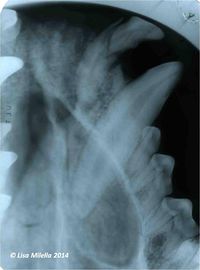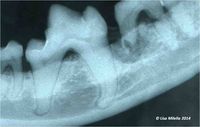Difference between revisions of "Tooth Fractures"
LisaMilella (talk | contribs) |
Michuang0720 (talk | contribs) |
||
| (8 intermediate revisions by 2 users not shown) | |||
| Line 1: | Line 1: | ||
{{OpenPagesTop}} | {{OpenPagesTop}} | ||
==Introduction== | ==Introduction== | ||
| − | Tooth fractures may affect the [[ | + | [[File:Tooth root fracture.jpg|200px|right|thumb|Root fracture]] |
| + | [[File:Tooth root fracture 2.jpg|200px|right|thumb|Root fracture]] | ||
| + | Tooth fractures may affect the [[Tooth - Anatomy & Physiology#Crown|crown]], the crown and the [[Tooth - Anatomy & Physiology#Root|root]] or just the root. | ||
Fractures are termed '''complicated''' if there is exposure of the pulp. | Fractures are termed '''complicated''' if there is exposure of the pulp. | ||
| Line 17: | Line 19: | ||
==Classification of tooth fractures== | ==Classification of tooth fractures== | ||
| − | :'''Class A1''' – involves the [[ | + | :'''Class A1''' – involves the [[Tooth - Anatomy & Physiology#Enamel|enamel]] only |
| − | :'''Class A2a''' – involves the enamel and [[ | + | :'''Class A2a''' – involves the enamel and [[Tooth - Anatomy & Physiology#Dentin|dentine]] but has not exposed the [[Tooth - Anatomy & Physiology#Pulp|pulp chamber]] |
:'''Class A2b''' – involves the enamel and dentine but has also exposed the pulp cavity | :'''Class A2b''' – involves the enamel and dentine but has also exposed the pulp cavity | ||
| Line 26: | Line 28: | ||
Crown fractures are usually obvious visually. | Crown fractures are usually obvious visually. | ||
| − | <u>Enamel fracture</u>: if only the [[ | + | <u>Enamel fracture</u>: if only the [[Tooth - Anatomy & Physiology#Enamel|enamel]] is fractured, this will appear as chips in the enamel surface. |
The treatment of choice is to smooth any sharp edges with fine diamond burs or sanding disks in order to prevent trauma to the lips and tongue. | The treatment of choice is to smooth any sharp edges with fine diamond burs or sanding disks in order to prevent trauma to the lips and tongue. | ||
| Line 32: | Line 34: | ||
[[Intra-Oral Radiography - Small Animal|'''Radiography''']] should be obtained to check for any apical root fractures and a follow-up radiograph should be performed within the year to check for periapical pathology. | [[Intra-Oral Radiography - Small Animal|'''Radiography''']] should be obtained to check for any apical root fractures and a follow-up radiograph should be performed within the year to check for periapical pathology. | ||
| − | <u>Enamel and [[ | + | <u>Enamel and [[Tooth - Anatomy & Physiology#Dentine|dentin]] fracture</u>: this provides a direct pathway for bacteria to the pulp via the dentinal tubules. [[Tooth - Anatomy & Physiology#Pulp|Pulp]] exposure should be evaluated for by probing with an [[Dental Explorer|explorer tip]] with the animal [[Oral Examination Under General Anaesthesia|under general anaesthesia]]. Radiographs should be taken to evaluate the root. |
| − | *'''Indirect pulp capping''': covers exposed dentin with | + | *'''Indirect pulp capping''': covers exposed dentin with a crown restoration. Follow-up radiographs are taken at 6-monthly intervals. |
| − | *'''Direct pulp capping''': the dentin is removed and the pulp is covered with calcium hydroxide or | + | *'''Direct pulp capping''': the dentin is removed and the pulp is covered with calcium hydroxide or mineral trioxide aggregate (MTA), followed by crown restoration. |
| − | <u>Enamel and dentin fracture with pulp exposure</u>: if the pulp is exposed '''endodontic treatment''' must be performed or the tooth must be '''extracted'''. An untreated exposed pulp leads to necrosis of tissue in the direction of the [[ | + | <u>Enamel and dentin fracture with pulp exposure</u>: if the pulp is exposed [[Endodontic Treatment|'''endodontic treatment''']] must be performed or the tooth must be [[Exodontics|'''extracted''']]. An untreated exposed pulp leads to necrosis of tissue in the direction of the [[Tooth - Anatomy & Physiology#Root|root]] apex. |
==Crown-Root Fracture== | ==Crown-Root Fracture== | ||
| − | A crown-root fracture involves the enamel, dentine and [[ | + | A crown-root fracture involves the enamel, dentine and [[Tooth - Anatomy & Physiology#Cementum|cementum]]. It can be further classified into complicated or uncomplicated. |
==Root Fracture== | ==Root Fracture== | ||
A root fracture involves dentin, cementum and pulp and is generally complicated. | A root fracture involves dentin, cementum and pulp and is generally complicated. | ||
| − | Some root fractures which are reasonably stable, horizontal and uncontaminated, may heal unaided with the pulp remaining vital. The [[ | + | Some root fractures which are reasonably stable, horizontal and uncontaminated, may heal unaided with the pulp remaining vital. The [[Tooth - Anatomy & Physiology#Alveolar Bone|alveolus]] acts as a '''natural splint''' which maintains the segments of tooth in close proximity. |
If the fracture is unstable, the coronal segment of the fracture should be removed and the apical segment either extracted or treated endodontically. | If the fracture is unstable, the coronal segment of the fracture should be removed and the apical segment either extracted or treated endodontically. | ||
| Line 81: | Line 83: | ||
{{Learning | {{Learning | ||
| + | |Vetstream = [https://www.vetstream.com/felis/Content/Disease/dis00709.asp Dental fracture]<br>[https://www.vetstream.com/felis/Content/Disease/dis60698.asp Dental trauma: root fracture] | ||
|flashcards = [[Veterinary Dentistry Q&A 06]] | |flashcards = [[Veterinary Dentistry Q&A 06]] | ||
}} | }} | ||
| Line 93: | Line 96: | ||
Wiggs, R. (1997) '''Veterinary Dentistry: principles and practice''' ''Wiley-Blackwell'' | Wiggs, R. (1997) '''Veterinary Dentistry: principles and practice''' ''Wiley-Blackwell'' | ||
| + | {{Lisa Milella reviewed | ||
| + | |date = 14 August 2014}} | ||
| − | {{ | + | |
| + | {{Waltham}} | ||
{{OpenPages}} | {{OpenPages}} | ||
| Line 101: | Line 107: | ||
[[Category:Dental Diseases - Dog]] | [[Category:Dental Diseases - Dog]] | ||
[[Category:Dental Diseases - Cat]] | [[Category:Dental Diseases - Cat]] | ||
| − | [[Category: | + | [[Category:Lisa Milella reviewed]] |
[[Category:Endodontic Conditions]] | [[Category:Endodontic Conditions]] | ||
[[Category:Traumatic Dental Conditions]] | [[Category:Traumatic Dental Conditions]] | ||
| + | [[Category:Waltham reviewed]] | ||
Latest revision as of 20:07, 4 June 2016
Introduction
Tooth fractures may affect the crown, the crown and the root or just the root.
Fractures are termed complicated if there is exposure of the pulp.
Signalment
All teeth are susceptible to fracture, but in the mature dog and cat, maxillary canines are most commonly broken, followed by the mandibular canine, the maxillary fourth premolars, and incisors. In the immature dog less than 6 months old, deciduous canine teeth are the teeth that most commonly fracture.
Aetiology
Causes of fracture include: chewing on metal fences or gates, hard chew toys, stones, ice cubes, horse and cow hooves.
A slab fracture of the carnassial tooth usually results from dogs chewing, whilst trauma to the anterior teeth (canines and incisors) results from catching a hard object for eg. Stones/Frisbees. Trauma to the front teeth can also result from an anterior collision – with a stationary object or another dog.
External head trauma from road traffic accidents (RTAs) or external blows/kicks can also result in tooth fractures.
Classification of tooth fractures
- Class A1 – involves the enamel only
- Class A2a – involves the enamel and dentine but has not exposed the pulp chamber
- Class A2b – involves the enamel and dentine but has also exposed the pulp cavity
Fractures may also be classified as crown only, crown-root fractures or root fracture.
Crown Fractures
Crown fractures are usually obvious visually.
Enamel fracture: if only the enamel is fractured, this will appear as chips in the enamel surface.
The treatment of choice is to smooth any sharp edges with fine diamond burs or sanding disks in order to prevent trauma to the lips and tongue.
Radiography should be obtained to check for any apical root fractures and a follow-up radiograph should be performed within the year to check for periapical pathology.
Enamel and dentin fracture: this provides a direct pathway for bacteria to the pulp via the dentinal tubules. Pulp exposure should be evaluated for by probing with an explorer tip with the animal under general anaesthesia. Radiographs should be taken to evaluate the root.
- Indirect pulp capping: covers exposed dentin with a crown restoration. Follow-up radiographs are taken at 6-monthly intervals.
- Direct pulp capping: the dentin is removed and the pulp is covered with calcium hydroxide or mineral trioxide aggregate (MTA), followed by crown restoration.
Enamel and dentin fracture with pulp exposure: if the pulp is exposed endodontic treatment must be performed or the tooth must be extracted. An untreated exposed pulp leads to necrosis of tissue in the direction of the root apex.
Crown-Root Fracture
A crown-root fracture involves the enamel, dentine and cementum. It can be further classified into complicated or uncomplicated.
Root Fracture
A root fracture involves dentin, cementum and pulp and is generally complicated.
Some root fractures which are reasonably stable, horizontal and uncontaminated, may heal unaided with the pulp remaining vital. The alveolus acts as a natural splint which maintains the segments of tooth in close proximity.
If the fracture is unstable, the coronal segment of the fracture should be removed and the apical segment either extracted or treated endodontically.
Endodontic Treatment
Treatment and prognosis of fractures depends on:
- The degree of displacement and mobility of the fracture segments
- The extent of contamination
- The amount of damage to the alveolar crest bone
For complicated fractures, endodontic treatment should be performed in adult animals.
Mature teeth have narrow pulp cavities and fully formed roots. Root canal treatment involves:
- Cleaning out the remaining pulp
- Shaping and disinfecting the root canal
- Filling the root
- Restoring the surface
Crown Restoration
Fractures with pulp exposure require endodontic treatment but the prosthodontic build-up of the crown is optional.
It may be sufficient to simply close the fracture sites with composite resin.
Full crown restoration may be important for working dogs who rely on normally functioning teeth. It may also be of aesthetic advantage in show dogs.
It may also be indicated to protect the tooth against further trauma. It will reduce the risk of further breakdown of the remaining tooth structure.
Restoration of the tooth structure may help prevent periodontal disease by preventing food entrapment in the gingiva.
Radiography should be performed regularly to check for periapical inflammation or bone disorders.
Prevention
Chewing hard objects should be avoided. Stones, bones and certain toys are harder than the tooth substance and can result in fracture of the tooth.
| Tooth Fractures Learning Resources | |
|---|---|
To reach the Vetstream content, please select |
Canis, Felis, Lapis or Equis |
 Test your knowledge using flashcard type questions |
Veterinary Dentistry Q&A 06 |
References
Verstaete, F. (1999) Veterinary Dentistry: Self assessment colour review Manson Publishing
Gorrel, C. (2004) Veterinary Dentistry for the General Practitioner Elsevier Health Sciences
Bellows, J. (1999) The practice of veterinary dentistry: a team effort Wiley-Blackwell
Wiggs, R. (1997) Veterinary Dentistry: principles and practice Wiley-Blackwell
| This article was expert reviewed by Lisa Milella BVSc DipEVDC MRCVS. Date reviewed: 14 August 2014 |
| Endorsed by WALTHAM®, a leading authority in companion animal nutrition and wellbeing for over 50 years and the science institute for Mars Petcare. |
Error in widget FBRecommend: unable to write file /var/www/wikivet.net/extensions/Widgets/compiled_templates/wrt662d6b0bafd3e6_23571242 Error in widget google+: unable to write file /var/www/wikivet.net/extensions/Widgets/compiled_templates/wrt662d6b0bb30688_58262198 Error in widget TwitterTweet: unable to write file /var/www/wikivet.net/extensions/Widgets/compiled_templates/wrt662d6b0bb5dc05_10518684
|
| WikiVet® Introduction - Help WikiVet - Report a Problem |

